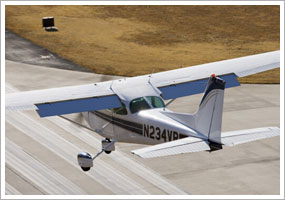
The following stories from the February 1, 2008, edition of AOPA ePilot were provided to AOPA members who expressed an interest in the particular subject areas. Any AOPA member can receive information tailored to their areas of interest by updating their preferences online.
My ePilot - Turbine Interest
ECLIPSE SIMULATOR APPROVED FOR TYPE RATINGS
Eclipse Aviation has received FAA approval to conduct pilot type rating training and checking in full-motion flight simulators, eliminating the need to use Eclipse 500 very light jets for these purposes. Read more on AOPA Online.
My ePilot - Student Interest, Training Tips
FLAPS: WHEN AND WHY
 Most student pilots train in aircraft equipped with flaps. In the traffic pattern, the flaps are typically deployed gradually, starting abeam the runway numbers and ending with full deployment on final approach. Many students ask: Why not deploy the flaps all at once?
Most student pilots train in aircraft equipped with flaps. In the traffic pattern, the flaps are typically deployed gradually, starting abeam the runway numbers and ending with full deployment on final approach. Many students ask: Why not deploy the flaps all at once?
"Large flap deflections at one single point in the landing pattern produce large lift changes that require significant pitch and power changes in order to maintain airspeed and descent angle. Consequently, the deflection of flaps at certain points in the landing pattern has definite advantages. Incremental deflection of flaps on downwind, base leg, and final approach allow smaller adjustment of pitch and power compared to extension of full flaps all at one time," explains Chapter 8 of the Airplane Flying Handbook.
Here is how a flight instructor described the method in a "Flight Forum" letter in the December 2005 issue of AOPA Flight Training: "When teaching landings in a Cessna or Piper training aircraft, I have the student use one notch of flaps and trim when abeam the numbers. From here, the remaining flaps are used to adjust the aircraft's descent to the touchdown point. If the pattern is a normal-sized pattern (the turn from base to final will be slightly more than a quarter-mile from the runway), and the headwinds on final are light, the second notch of flaps will be applied when they are needed to keep from landing long. This typically occurs just before turning from base to final. The third and last notch of flaps is applied when the landing is assured."
But don't let that comfortable routine make you complacent. Unusual winds, extending your downwind leg for spacing, or getting instructions from the tower to "make short approach" [described in the May 26, 2006, Training Tip ] may call for other techniques (and don't forget to perform some no-flap landings).
During dual sessions of airwork, it will help if you spend some time practicing holding heading and altitude at approach airspeeds while changing flap configurations-full flaps, no flaps, and everything in between-to learn the aircraft's responses and the power-pitch inputs required. With some practice, you'll be ready for whatever kind of landing is called for next!
My ePilot - Training Product
SPORTY'S INTRODUCES NONPILOT'S GUIDE TO FLYING DVD
You're close to taking your checkride, and you can't wait for the day when at long last you can take your significant other for a ride and a $100 hamburger. But that person isn't a pilot, and he or she just isn't sure about the whole idea of going flying with you. Here's an opportunity to introduce your future flying companion to the joys of flight with a DVD designed specifically for nonpilots. Introduction to Flying: A Non-Pilot's Guide from Sporty's explains everything in layman's terms, not pilot jargon, with the intention of "taking the mystery" out of what you do and why you do it. The 56-minute program is available on DVD or for direct download for $29.95, and it can be ordered online or by calling 800/SPORTYS.
Note: Products listed have not been evaluated by ePilot editors unless otherwise noted. AOPA assumes no responsibility for products or services listed or for claims or actions by manufacturers or vendors.
My ePilot - Student Interest, Final Exam
Question: I occasionally become confused about how to anticipate and enter the proper traffic pattern when flying into an unfamiliar airport. Do you have any suggestions to help me out before my next cross-country flight?
Answer: During your preflight planning, consider drawing out the layout of the runway(s) on your navigation log and labeling each end appropriately. Next, based upon your direction of flight to the airport, place an "x and arrow" to represent your aircraft's inbound flight path toward the airport. This will allow you to visualize how to enter and/or modify your flight path into the proper traffic pattern once you determine what runway is in use at a nontowered airport or obtain clearance instructions from air traffic control at a towered airport. For more information on use of runways, see Chapter 4, Section 3, "Airport Operations," of the Aeronautical Information Manual.
Got a question for our technical services staff? E-mail to [email protected] or call the Pilot Information Center, 800/872-2672. Don't forget the online archive of "Final Exam" questions and answers, searchable by keyword or topic.


